Anorexia Nervosa: Examining Biological Theories and Treatment Options
VerifiedAdded on 2023/04/03
|9
|2035
|302
Essay
AI Summary
This essay provides a comprehensive overview of anorexia nervosa, defining it as a relentless pursuit of thinness driven by an intense fear of gaining weight and distorted body image. It discusses the symptoms, including physical signs like severe weight loss, insomnia, and emotional/behavioral aspects such as food preoccupation, social withdrawal, and excessive exercise. The essay highlights the prevalence rates, noting that anorexia nervosa has one of the highest mortality rates among mental disorders. It delves into the biological theories, particularly the role of genetics and abnormalities in the hypothalamus, and explores various treatment options, including medical interventions, nutritional support, and therapy, while also addressing the use of medications like antidepressants and their potential side effects. The essay concludes by emphasizing the need for holistic and integrative treatment approaches to manage and control this eating disorder effectively.
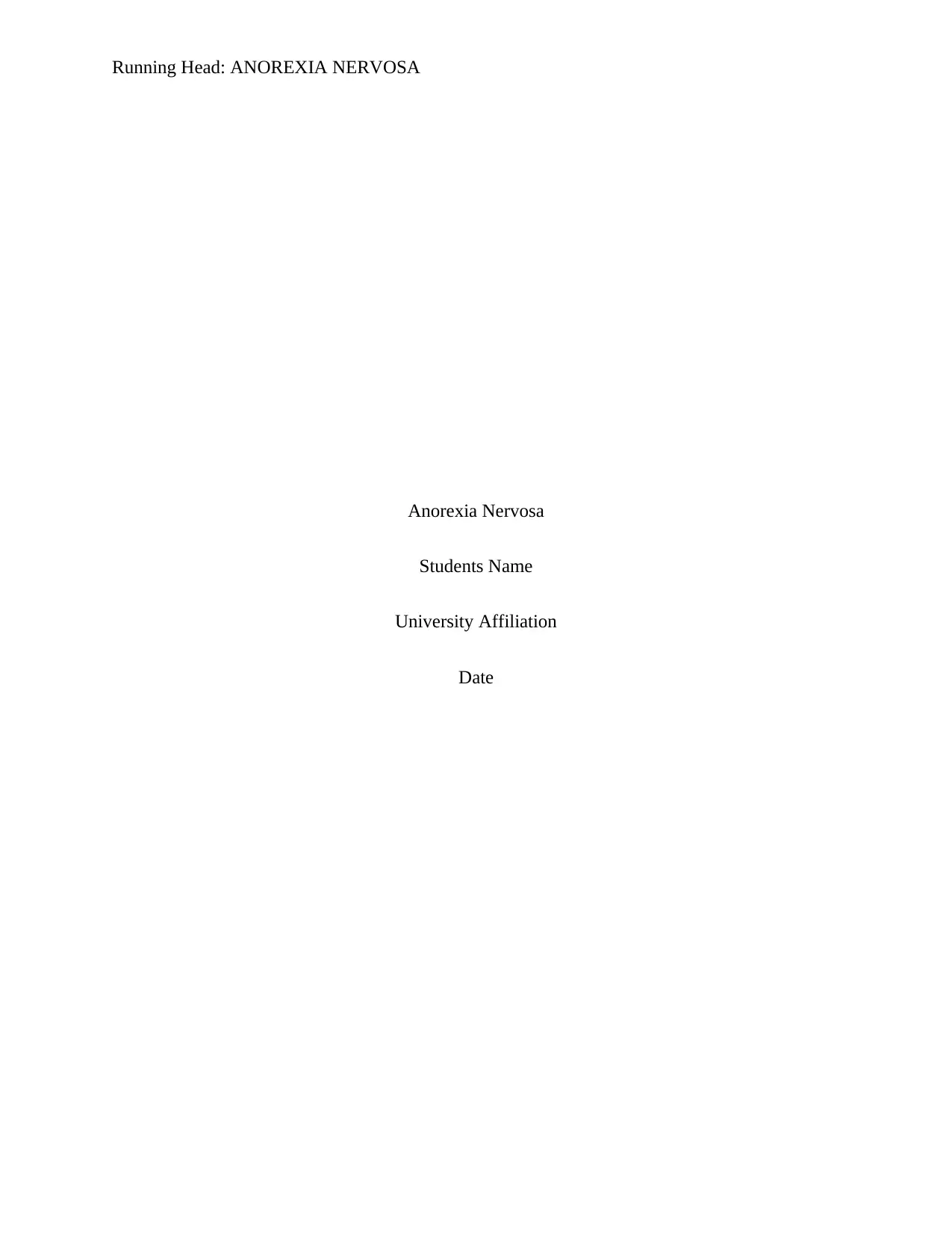
Running Head: ANOREXIA NERVOSA
Anorexia Nervosa
Students Name
University Affiliation
Date
Anorexia Nervosa
Students Name
University Affiliation
Date
Paraphrase This Document
Need a fresh take? Get an instant paraphrase of this document with our AI Paraphraser
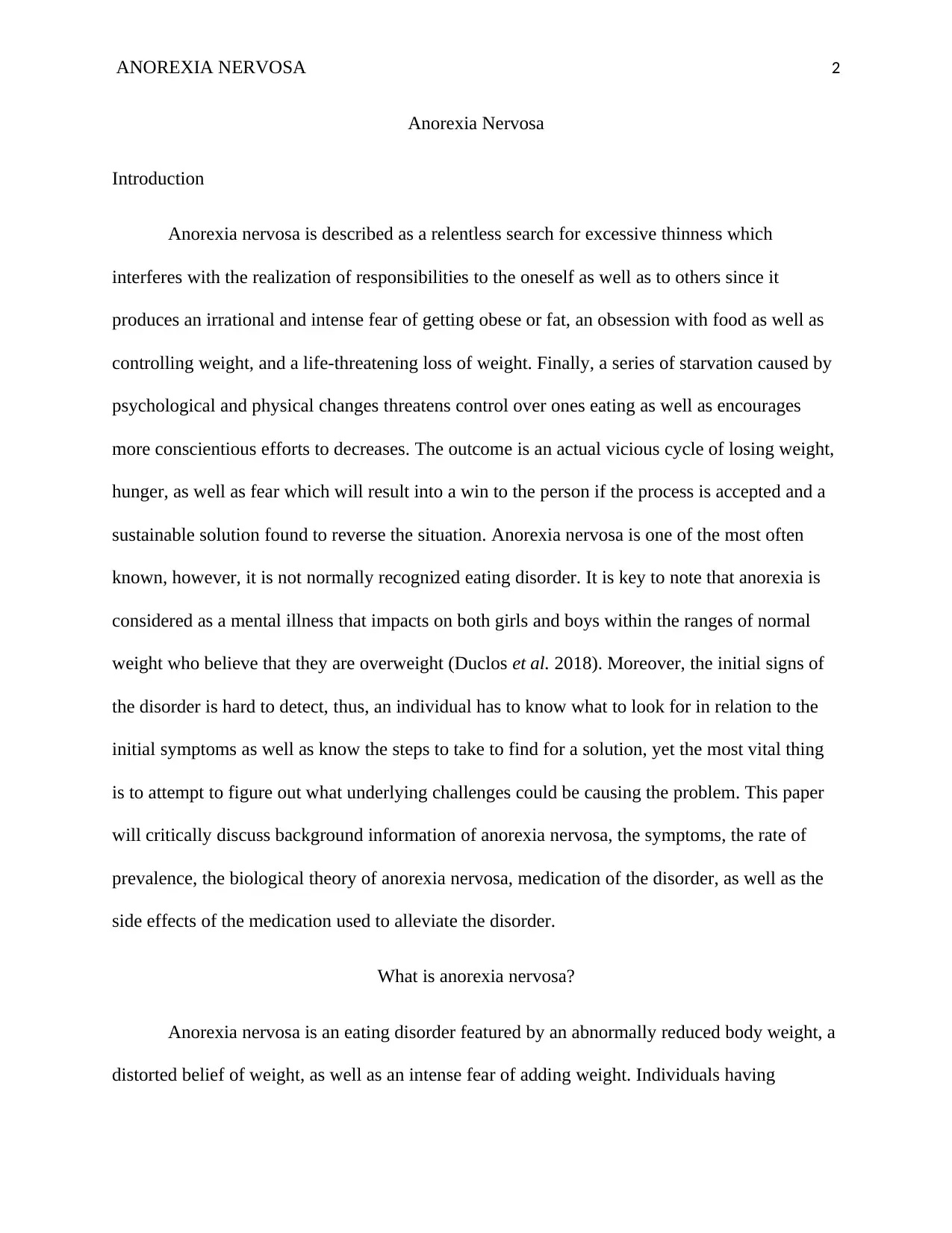
ANOREXIA NERVOSA 2
Anorexia Nervosa
Introduction
Anorexia nervosa is described as a relentless search for excessive thinness which
interferes with the realization of responsibilities to the oneself as well as to others since it
produces an irrational and intense fear of getting obese or fat, an obsession with food as well as
controlling weight, and a life-threatening loss of weight. Finally, a series of starvation caused by
psychological and physical changes threatens control over ones eating as well as encourages
more conscientious efforts to decreases. The outcome is an actual vicious cycle of losing weight,
hunger, as well as fear which will result into a win to the person if the process is accepted and a
sustainable solution found to reverse the situation. Anorexia nervosa is one of the most often
known, however, it is not normally recognized eating disorder. It is key to note that anorexia is
considered as a mental illness that impacts on both girls and boys within the ranges of normal
weight who believe that they are overweight (Duclos et al. 2018). Moreover, the initial signs of
the disorder is hard to detect, thus, an individual has to know what to look for in relation to the
initial symptoms as well as know the steps to take to find for a solution, yet the most vital thing
is to attempt to figure out what underlying challenges could be causing the problem. This paper
will critically discuss background information of anorexia nervosa, the symptoms, the rate of
prevalence, the biological theory of anorexia nervosa, medication of the disorder, as well as the
side effects of the medication used to alleviate the disorder.
What is anorexia nervosa?
Anorexia nervosa is an eating disorder featured by an abnormally reduced body weight, a
distorted belief of weight, as well as an intense fear of adding weight. Individuals having
Anorexia Nervosa
Introduction
Anorexia nervosa is described as a relentless search for excessive thinness which
interferes with the realization of responsibilities to the oneself as well as to others since it
produces an irrational and intense fear of getting obese or fat, an obsession with food as well as
controlling weight, and a life-threatening loss of weight. Finally, a series of starvation caused by
psychological and physical changes threatens control over ones eating as well as encourages
more conscientious efforts to decreases. The outcome is an actual vicious cycle of losing weight,
hunger, as well as fear which will result into a win to the person if the process is accepted and a
sustainable solution found to reverse the situation. Anorexia nervosa is one of the most often
known, however, it is not normally recognized eating disorder. It is key to note that anorexia is
considered as a mental illness that impacts on both girls and boys within the ranges of normal
weight who believe that they are overweight (Duclos et al. 2018). Moreover, the initial signs of
the disorder is hard to detect, thus, an individual has to know what to look for in relation to the
initial symptoms as well as know the steps to take to find for a solution, yet the most vital thing
is to attempt to figure out what underlying challenges could be causing the problem. This paper
will critically discuss background information of anorexia nervosa, the symptoms, the rate of
prevalence, the biological theory of anorexia nervosa, medication of the disorder, as well as the
side effects of the medication used to alleviate the disorder.
What is anorexia nervosa?
Anorexia nervosa is an eating disorder featured by an abnormally reduced body weight, a
distorted belief of weight, as well as an intense fear of adding weight. Individuals having
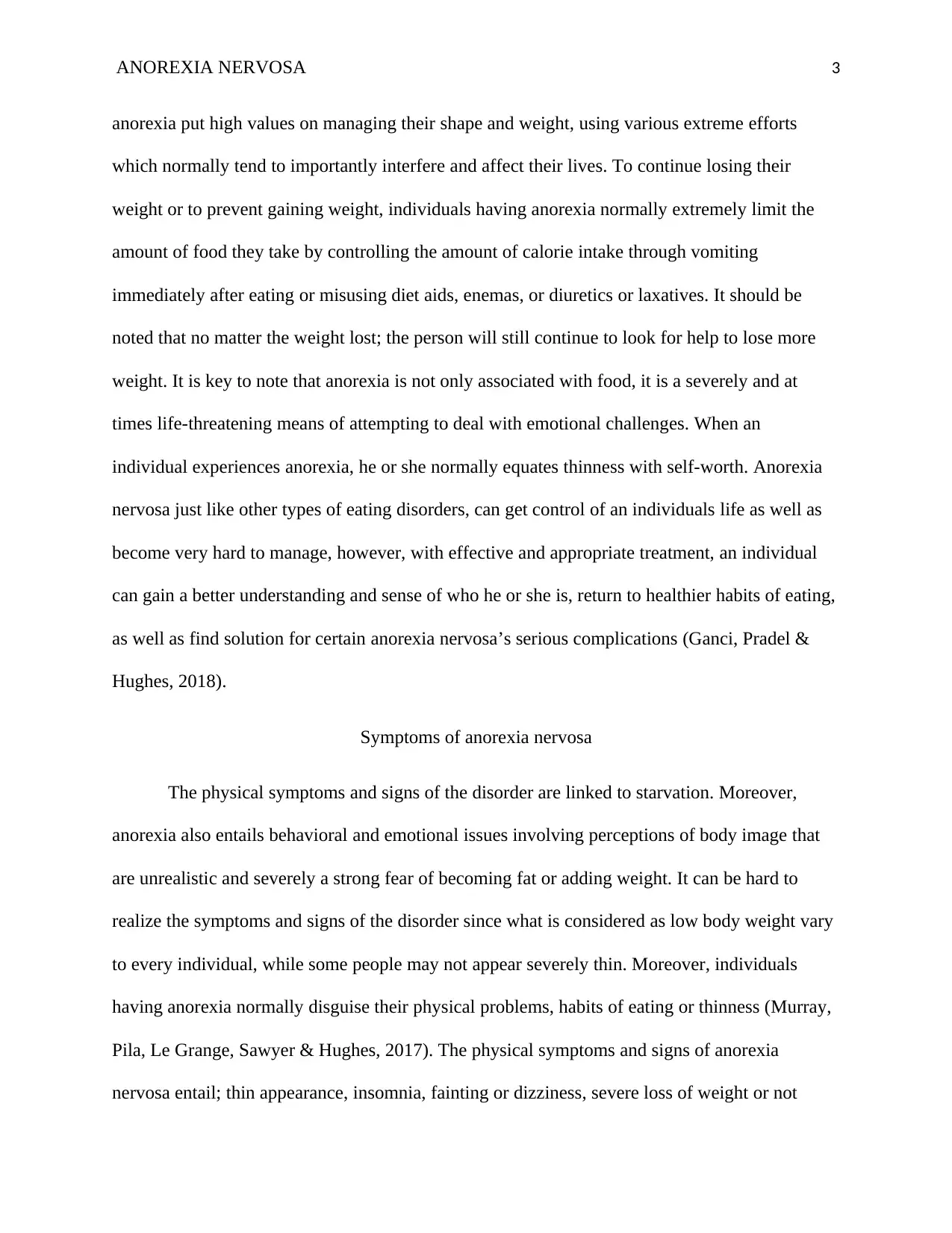
ANOREXIA NERVOSA 3
anorexia put high values on managing their shape and weight, using various extreme efforts
which normally tend to importantly interfere and affect their lives. To continue losing their
weight or to prevent gaining weight, individuals having anorexia normally extremely limit the
amount of food they take by controlling the amount of calorie intake through vomiting
immediately after eating or misusing diet aids, enemas, or diuretics or laxatives. It should be
noted that no matter the weight lost; the person will still continue to look for help to lose more
weight. It is key to note that anorexia is not only associated with food, it is a severely and at
times life-threatening means of attempting to deal with emotional challenges. When an
individual experiences anorexia, he or she normally equates thinness with self-worth. Anorexia
nervosa just like other types of eating disorders, can get control of an individuals life as well as
become very hard to manage, however, with effective and appropriate treatment, an individual
can gain a better understanding and sense of who he or she is, return to healthier habits of eating,
as well as find solution for certain anorexia nervosa’s serious complications (Ganci, Pradel &
Hughes, 2018).
Symptoms of anorexia nervosa
The physical symptoms and signs of the disorder are linked to starvation. Moreover,
anorexia also entails behavioral and emotional issues involving perceptions of body image that
are unrealistic and severely a strong fear of becoming fat or adding weight. It can be hard to
realize the symptoms and signs of the disorder since what is considered as low body weight vary
to every individual, while some people may not appear severely thin. Moreover, individuals
having anorexia normally disguise their physical problems, habits of eating or thinness (Murray,
Pila, Le Grange, Sawyer & Hughes, 2017). The physical symptoms and signs of anorexia
nervosa entail; thin appearance, insomnia, fainting or dizziness, severe loss of weight or not
anorexia put high values on managing their shape and weight, using various extreme efforts
which normally tend to importantly interfere and affect their lives. To continue losing their
weight or to prevent gaining weight, individuals having anorexia normally extremely limit the
amount of food they take by controlling the amount of calorie intake through vomiting
immediately after eating or misusing diet aids, enemas, or diuretics or laxatives. It should be
noted that no matter the weight lost; the person will still continue to look for help to lose more
weight. It is key to note that anorexia is not only associated with food, it is a severely and at
times life-threatening means of attempting to deal with emotional challenges. When an
individual experiences anorexia, he or she normally equates thinness with self-worth. Anorexia
nervosa just like other types of eating disorders, can get control of an individuals life as well as
become very hard to manage, however, with effective and appropriate treatment, an individual
can gain a better understanding and sense of who he or she is, return to healthier habits of eating,
as well as find solution for certain anorexia nervosa’s serious complications (Ganci, Pradel &
Hughes, 2018).
Symptoms of anorexia nervosa
The physical symptoms and signs of the disorder are linked to starvation. Moreover,
anorexia also entails behavioral and emotional issues involving perceptions of body image that
are unrealistic and severely a strong fear of becoming fat or adding weight. It can be hard to
realize the symptoms and signs of the disorder since what is considered as low body weight vary
to every individual, while some people may not appear severely thin. Moreover, individuals
having anorexia normally disguise their physical problems, habits of eating or thinness (Murray,
Pila, Le Grange, Sawyer & Hughes, 2017). The physical symptoms and signs of anorexia
nervosa entail; thin appearance, insomnia, fainting or dizziness, severe loss of weight or not
⊘ This is a preview!⊘
Do you want full access?
Subscribe today to unlock all pages.

Trusted by 1+ million students worldwide
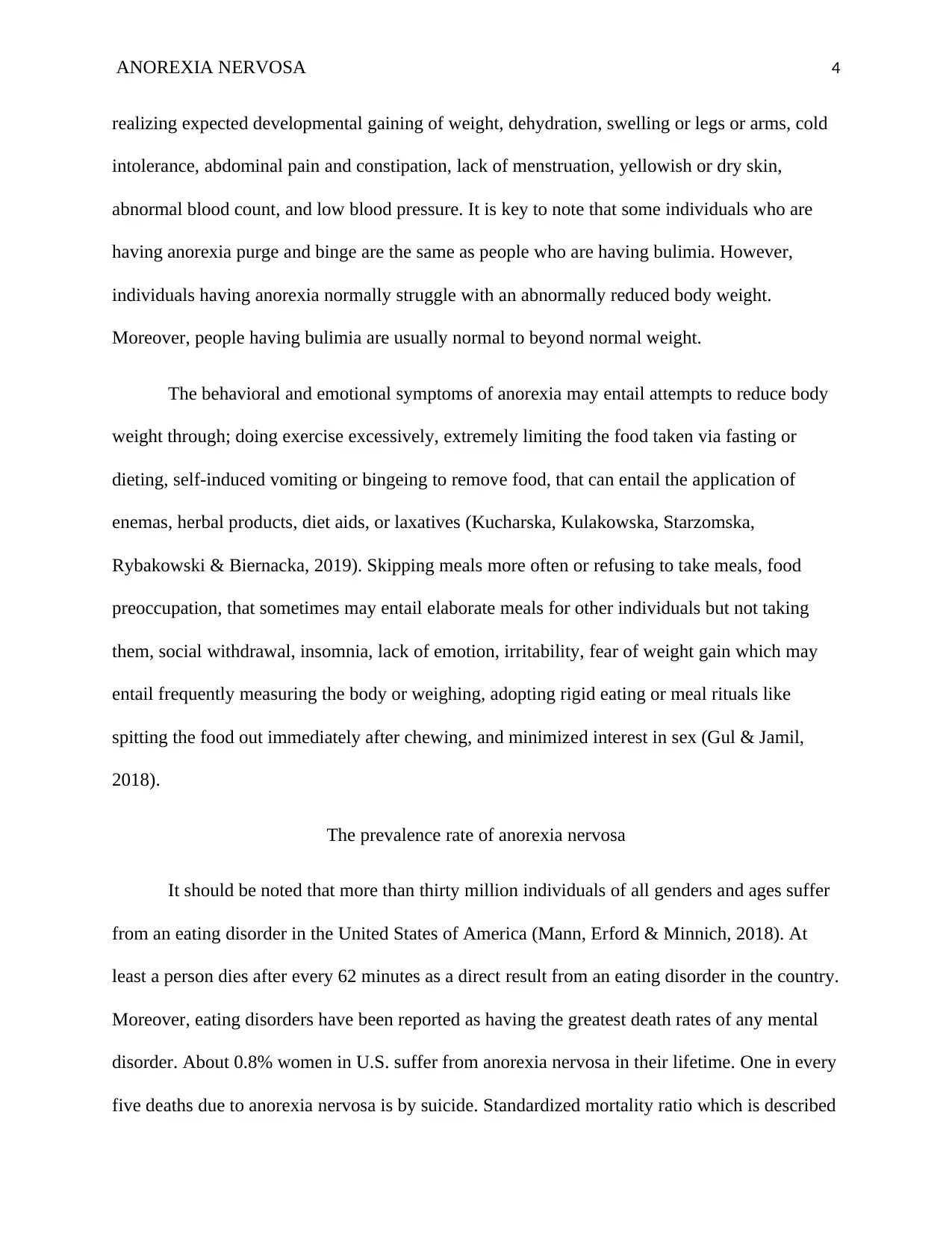
ANOREXIA NERVOSA 4
realizing expected developmental gaining of weight, dehydration, swelling or legs or arms, cold
intolerance, abdominal pain and constipation, lack of menstruation, yellowish or dry skin,
abnormal blood count, and low blood pressure. It is key to note that some individuals who are
having anorexia purge and binge are the same as people who are having bulimia. However,
individuals having anorexia normally struggle with an abnormally reduced body weight.
Moreover, people having bulimia are usually normal to beyond normal weight.
The behavioral and emotional symptoms of anorexia may entail attempts to reduce body
weight through; doing exercise excessively, extremely limiting the food taken via fasting or
dieting, self-induced vomiting or bingeing to remove food, that can entail the application of
enemas, herbal products, diet aids, or laxatives (Kucharska, Kulakowska, Starzomska,
Rybakowski & Biernacka, 2019). Skipping meals more often or refusing to take meals, food
preoccupation, that sometimes may entail elaborate meals for other individuals but not taking
them, social withdrawal, insomnia, lack of emotion, irritability, fear of weight gain which may
entail frequently measuring the body or weighing, adopting rigid eating or meal rituals like
spitting the food out immediately after chewing, and minimized interest in sex (Gul & Jamil,
2018).
The prevalence rate of anorexia nervosa
It should be noted that more than thirty million individuals of all genders and ages suffer
from an eating disorder in the United States of America (Mann, Erford & Minnich, 2018). At
least a person dies after every 62 minutes as a direct result from an eating disorder in the country.
Moreover, eating disorders have been reported as having the greatest death rates of any mental
disorder. About 0.8% women in U.S. suffer from anorexia nervosa in their lifetime. One in every
five deaths due to anorexia nervosa is by suicide. Standardized mortality ratio which is described
realizing expected developmental gaining of weight, dehydration, swelling or legs or arms, cold
intolerance, abdominal pain and constipation, lack of menstruation, yellowish or dry skin,
abnormal blood count, and low blood pressure. It is key to note that some individuals who are
having anorexia purge and binge are the same as people who are having bulimia. However,
individuals having anorexia normally struggle with an abnormally reduced body weight.
Moreover, people having bulimia are usually normal to beyond normal weight.
The behavioral and emotional symptoms of anorexia may entail attempts to reduce body
weight through; doing exercise excessively, extremely limiting the food taken via fasting or
dieting, self-induced vomiting or bingeing to remove food, that can entail the application of
enemas, herbal products, diet aids, or laxatives (Kucharska, Kulakowska, Starzomska,
Rybakowski & Biernacka, 2019). Skipping meals more often or refusing to take meals, food
preoccupation, that sometimes may entail elaborate meals for other individuals but not taking
them, social withdrawal, insomnia, lack of emotion, irritability, fear of weight gain which may
entail frequently measuring the body or weighing, adopting rigid eating or meal rituals like
spitting the food out immediately after chewing, and minimized interest in sex (Gul & Jamil,
2018).
The prevalence rate of anorexia nervosa
It should be noted that more than thirty million individuals of all genders and ages suffer
from an eating disorder in the United States of America (Mann, Erford & Minnich, 2018). At
least a person dies after every 62 minutes as a direct result from an eating disorder in the country.
Moreover, eating disorders have been reported as having the greatest death rates of any mental
disorder. About 0.8% women in U.S. suffer from anorexia nervosa in their lifetime. One in every
five deaths due to anorexia nervosa is by suicide. Standardized mortality ratio which is described
Paraphrase This Document
Need a fresh take? Get an instant paraphrase of this document with our AI Paraphraser
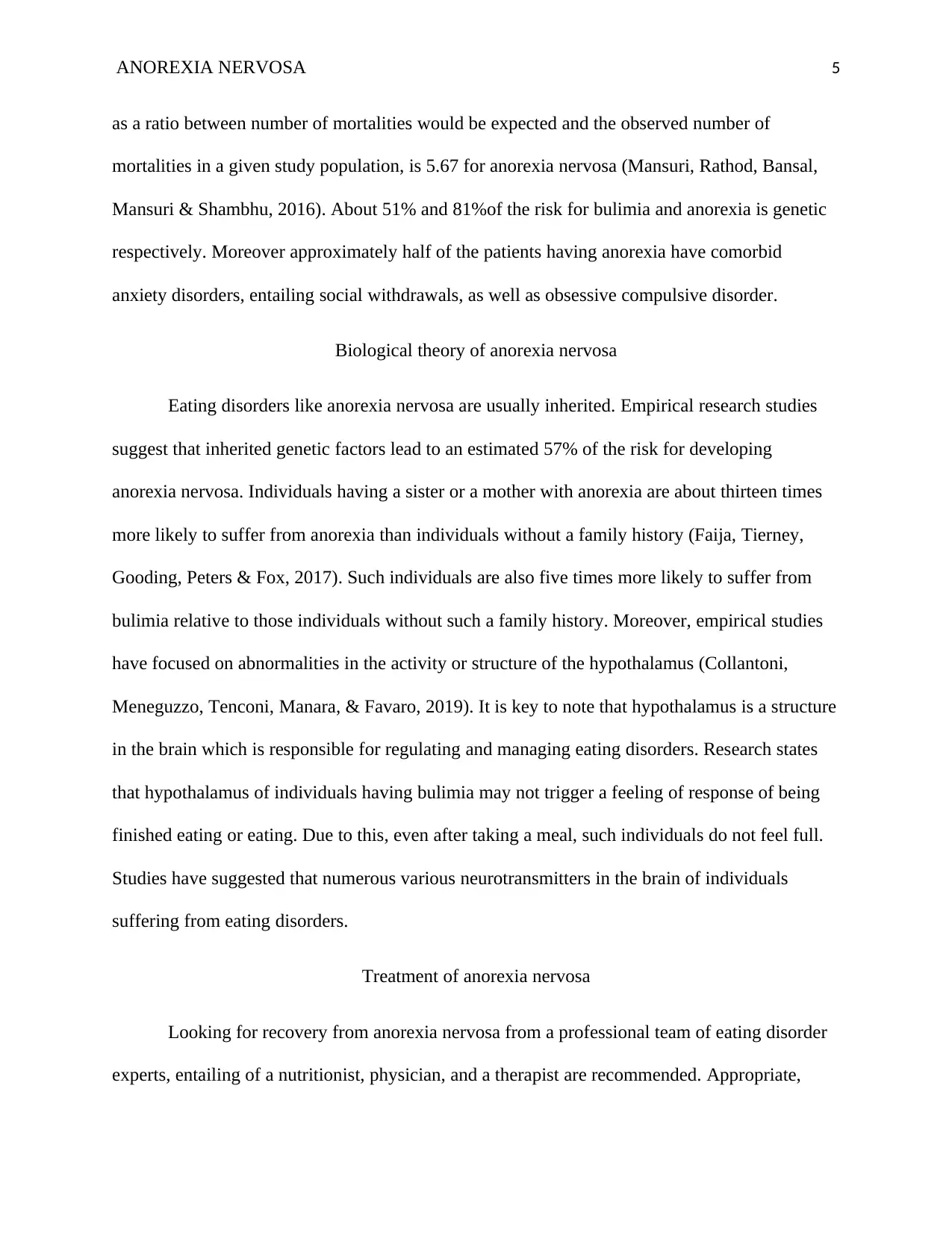
ANOREXIA NERVOSA 5
as a ratio between number of mortalities would be expected and the observed number of
mortalities in a given study population, is 5.67 for anorexia nervosa (Mansuri, Rathod, Bansal,
Mansuri & Shambhu, 2016). About 51% and 81%of the risk for bulimia and anorexia is genetic
respectively. Moreover approximately half of the patients having anorexia have comorbid
anxiety disorders, entailing social withdrawals, as well as obsessive compulsive disorder.
Biological theory of anorexia nervosa
Eating disorders like anorexia nervosa are usually inherited. Empirical research studies
suggest that inherited genetic factors lead to an estimated 57% of the risk for developing
anorexia nervosa. Individuals having a sister or a mother with anorexia are about thirteen times
more likely to suffer from anorexia than individuals without a family history (Faija, Tierney,
Gooding, Peters & Fox, 2017). Such individuals are also five times more likely to suffer from
bulimia relative to those individuals without such a family history. Moreover, empirical studies
have focused on abnormalities in the activity or structure of the hypothalamus (Collantoni,
Meneguzzo, Tenconi, Manara, & Favaro, 2019). It is key to note that hypothalamus is a structure
in the brain which is responsible for regulating and managing eating disorders. Research states
that hypothalamus of individuals having bulimia may not trigger a feeling of response of being
finished eating or eating. Due to this, even after taking a meal, such individuals do not feel full.
Studies have suggested that numerous various neurotransmitters in the brain of individuals
suffering from eating disorders.
Treatment of anorexia nervosa
Looking for recovery from anorexia nervosa from a professional team of eating disorder
experts, entailing of a nutritionist, physician, and a therapist are recommended. Appropriate,
as a ratio between number of mortalities would be expected and the observed number of
mortalities in a given study population, is 5.67 for anorexia nervosa (Mansuri, Rathod, Bansal,
Mansuri & Shambhu, 2016). About 51% and 81%of the risk for bulimia and anorexia is genetic
respectively. Moreover approximately half of the patients having anorexia have comorbid
anxiety disorders, entailing social withdrawals, as well as obsessive compulsive disorder.
Biological theory of anorexia nervosa
Eating disorders like anorexia nervosa are usually inherited. Empirical research studies
suggest that inherited genetic factors lead to an estimated 57% of the risk for developing
anorexia nervosa. Individuals having a sister or a mother with anorexia are about thirteen times
more likely to suffer from anorexia than individuals without a family history (Faija, Tierney,
Gooding, Peters & Fox, 2017). Such individuals are also five times more likely to suffer from
bulimia relative to those individuals without such a family history. Moreover, empirical studies
have focused on abnormalities in the activity or structure of the hypothalamus (Collantoni,
Meneguzzo, Tenconi, Manara, & Favaro, 2019). It is key to note that hypothalamus is a structure
in the brain which is responsible for regulating and managing eating disorders. Research states
that hypothalamus of individuals having bulimia may not trigger a feeling of response of being
finished eating or eating. Due to this, even after taking a meal, such individuals do not feel full.
Studies have suggested that numerous various neurotransmitters in the brain of individuals
suffering from eating disorders.
Treatment of anorexia nervosa
Looking for recovery from anorexia nervosa from a professional team of eating disorder
experts, entailing of a nutritionist, physician, and a therapist are recommended. Appropriate,
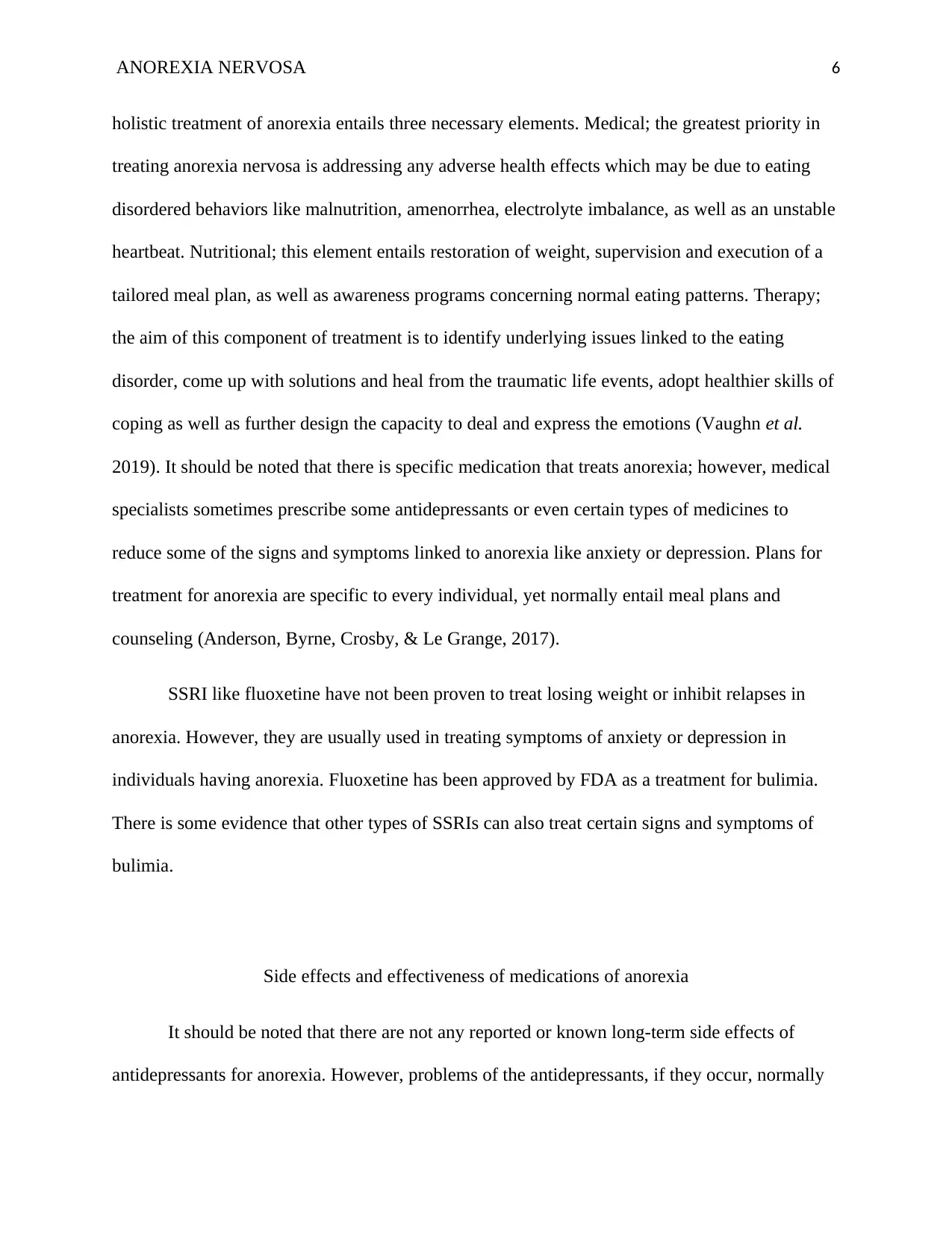
ANOREXIA NERVOSA 6
holistic treatment of anorexia entails three necessary elements. Medical; the greatest priority in
treating anorexia nervosa is addressing any adverse health effects which may be due to eating
disordered behaviors like malnutrition, amenorrhea, electrolyte imbalance, as well as an unstable
heartbeat. Nutritional; this element entails restoration of weight, supervision and execution of a
tailored meal plan, as well as awareness programs concerning normal eating patterns. Therapy;
the aim of this component of treatment is to identify underlying issues linked to the eating
disorder, come up with solutions and heal from the traumatic life events, adopt healthier skills of
coping as well as further design the capacity to deal and express the emotions (Vaughn et al.
2019). It should be noted that there is specific medication that treats anorexia; however, medical
specialists sometimes prescribe some antidepressants or even certain types of medicines to
reduce some of the signs and symptoms linked to anorexia like anxiety or depression. Plans for
treatment for anorexia are specific to every individual, yet normally entail meal plans and
counseling (Anderson, Byrne, Crosby, & Le Grange, 2017).
SSRI like fluoxetine have not been proven to treat losing weight or inhibit relapses in
anorexia. However, they are usually used in treating symptoms of anxiety or depression in
individuals having anorexia. Fluoxetine has been approved by FDA as a treatment for bulimia.
There is some evidence that other types of SSRIs can also treat certain signs and symptoms of
bulimia.
Side effects and effectiveness of medications of anorexia
It should be noted that there are not any reported or known long-term side effects of
antidepressants for anorexia. However, problems of the antidepressants, if they occur, normally
holistic treatment of anorexia entails three necessary elements. Medical; the greatest priority in
treating anorexia nervosa is addressing any adverse health effects which may be due to eating
disordered behaviors like malnutrition, amenorrhea, electrolyte imbalance, as well as an unstable
heartbeat. Nutritional; this element entails restoration of weight, supervision and execution of a
tailored meal plan, as well as awareness programs concerning normal eating patterns. Therapy;
the aim of this component of treatment is to identify underlying issues linked to the eating
disorder, come up with solutions and heal from the traumatic life events, adopt healthier skills of
coping as well as further design the capacity to deal and express the emotions (Vaughn et al.
2019). It should be noted that there is specific medication that treats anorexia; however, medical
specialists sometimes prescribe some antidepressants or even certain types of medicines to
reduce some of the signs and symptoms linked to anorexia like anxiety or depression. Plans for
treatment for anorexia are specific to every individual, yet normally entail meal plans and
counseling (Anderson, Byrne, Crosby, & Le Grange, 2017).
SSRI like fluoxetine have not been proven to treat losing weight or inhibit relapses in
anorexia. However, they are usually used in treating symptoms of anxiety or depression in
individuals having anorexia. Fluoxetine has been approved by FDA as a treatment for bulimia.
There is some evidence that other types of SSRIs can also treat certain signs and symptoms of
bulimia.
Side effects and effectiveness of medications of anorexia
It should be noted that there are not any reported or known long-term side effects of
antidepressants for anorexia. However, problems of the antidepressants, if they occur, normally
⊘ This is a preview!⊘
Do you want full access?
Subscribe today to unlock all pages.

Trusted by 1+ million students worldwide
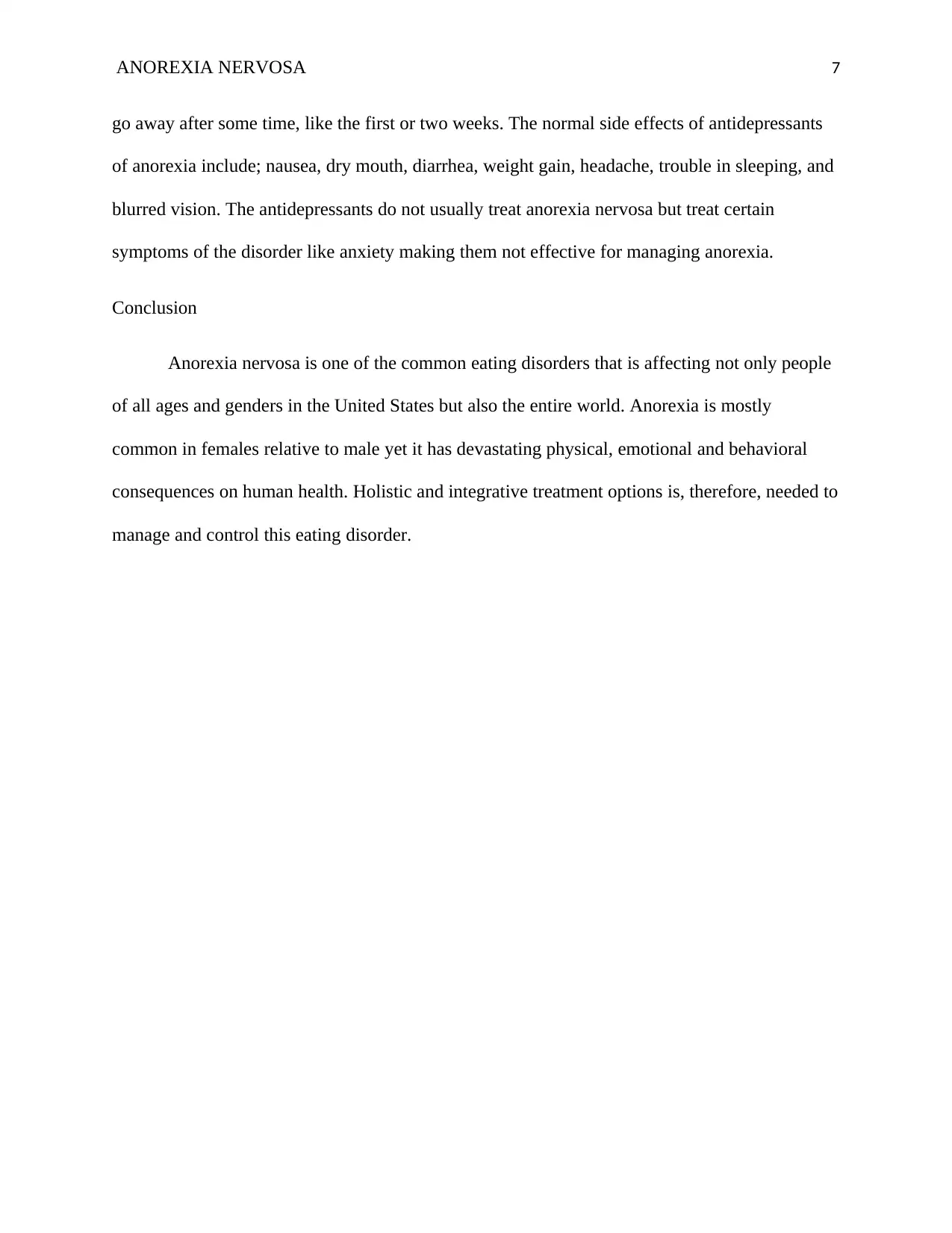
ANOREXIA NERVOSA 7
go away after some time, like the first or two weeks. The normal side effects of antidepressants
of anorexia include; nausea, dry mouth, diarrhea, weight gain, headache, trouble in sleeping, and
blurred vision. The antidepressants do not usually treat anorexia nervosa but treat certain
symptoms of the disorder like anxiety making them not effective for managing anorexia.
Conclusion
Anorexia nervosa is one of the common eating disorders that is affecting not only people
of all ages and genders in the United States but also the entire world. Anorexia is mostly
common in females relative to male yet it has devastating physical, emotional and behavioral
consequences on human health. Holistic and integrative treatment options is, therefore, needed to
manage and control this eating disorder.
go away after some time, like the first or two weeks. The normal side effects of antidepressants
of anorexia include; nausea, dry mouth, diarrhea, weight gain, headache, trouble in sleeping, and
blurred vision. The antidepressants do not usually treat anorexia nervosa but treat certain
symptoms of the disorder like anxiety making them not effective for managing anorexia.
Conclusion
Anorexia nervosa is one of the common eating disorders that is affecting not only people
of all ages and genders in the United States but also the entire world. Anorexia is mostly
common in females relative to male yet it has devastating physical, emotional and behavioral
consequences on human health. Holistic and integrative treatment options is, therefore, needed to
manage and control this eating disorder.
Paraphrase This Document
Need a fresh take? Get an instant paraphrase of this document with our AI Paraphraser
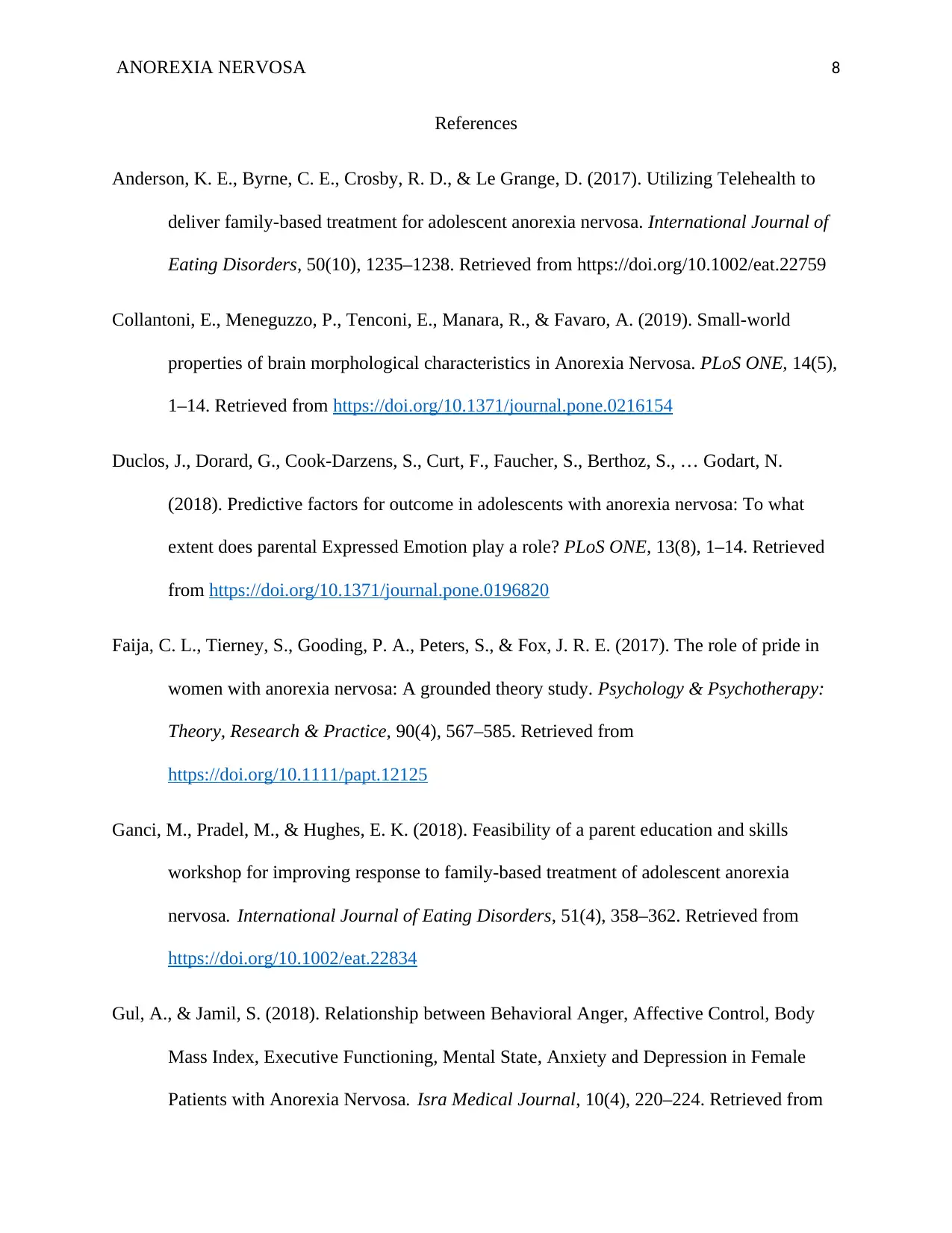
ANOREXIA NERVOSA 8
References
Anderson, K. E., Byrne, C. E., Crosby, R. D., & Le Grange, D. (2017). Utilizing Telehealth to
deliver family-based treatment for adolescent anorexia nervosa. International Journal of
Eating Disorders, 50(10), 1235–1238. Retrieved from https://doi.org/10.1002/eat.22759
Collantoni, E., Meneguzzo, P., Tenconi, E., Manara, R., & Favaro, A. (2019). Small-world
properties of brain morphological characteristics in Anorexia Nervosa. PLoS ONE, 14(5),
1–14. Retrieved from https://doi.org/10.1371/journal.pone.0216154
Duclos, J., Dorard, G., Cook-Darzens, S., Curt, F., Faucher, S., Berthoz, S., … Godart, N.
(2018). Predictive factors for outcome in adolescents with anorexia nervosa: To what
extent does parental Expressed Emotion play a role? PLoS ONE, 13(8), 1–14. Retrieved
from https://doi.org/10.1371/journal.pone.0196820
Faija, C. L., Tierney, S., Gooding, P. A., Peters, S., & Fox, J. R. E. (2017). The role of pride in
women with anorexia nervosa: A grounded theory study. Psychology & Psychotherapy:
Theory, Research & Practice, 90(4), 567–585. Retrieved from
https://doi.org/10.1111/papt.12125
Ganci, M., Pradel, M., & Hughes, E. K. (2018). Feasibility of a parent education and skills
workshop for improving response to family‐based treatment of adolescent anorexia
nervosa. International Journal of Eating Disorders, 51(4), 358–362. Retrieved from
https://doi.org/10.1002/eat.22834
Gul, A., & Jamil, S. (2018). Relationship between Behavioral Anger, Affective Control, Body
Mass Index, Executive Functioning, Mental State, Anxiety and Depression in Female
Patients with Anorexia Nervosa. Isra Medical Journal, 10(4), 220–224. Retrieved from
References
Anderson, K. E., Byrne, C. E., Crosby, R. D., & Le Grange, D. (2017). Utilizing Telehealth to
deliver family-based treatment for adolescent anorexia nervosa. International Journal of
Eating Disorders, 50(10), 1235–1238. Retrieved from https://doi.org/10.1002/eat.22759
Collantoni, E., Meneguzzo, P., Tenconi, E., Manara, R., & Favaro, A. (2019). Small-world
properties of brain morphological characteristics in Anorexia Nervosa. PLoS ONE, 14(5),
1–14. Retrieved from https://doi.org/10.1371/journal.pone.0216154
Duclos, J., Dorard, G., Cook-Darzens, S., Curt, F., Faucher, S., Berthoz, S., … Godart, N.
(2018). Predictive factors for outcome in adolescents with anorexia nervosa: To what
extent does parental Expressed Emotion play a role? PLoS ONE, 13(8), 1–14. Retrieved
from https://doi.org/10.1371/journal.pone.0196820
Faija, C. L., Tierney, S., Gooding, P. A., Peters, S., & Fox, J. R. E. (2017). The role of pride in
women with anorexia nervosa: A grounded theory study. Psychology & Psychotherapy:
Theory, Research & Practice, 90(4), 567–585. Retrieved from
https://doi.org/10.1111/papt.12125
Ganci, M., Pradel, M., & Hughes, E. K. (2018). Feasibility of a parent education and skills
workshop for improving response to family‐based treatment of adolescent anorexia
nervosa. International Journal of Eating Disorders, 51(4), 358–362. Retrieved from
https://doi.org/10.1002/eat.22834
Gul, A., & Jamil, S. (2018). Relationship between Behavioral Anger, Affective Control, Body
Mass Index, Executive Functioning, Mental State, Anxiety and Depression in Female
Patients with Anorexia Nervosa. Isra Medical Journal, 10(4), 220–224. Retrieved from
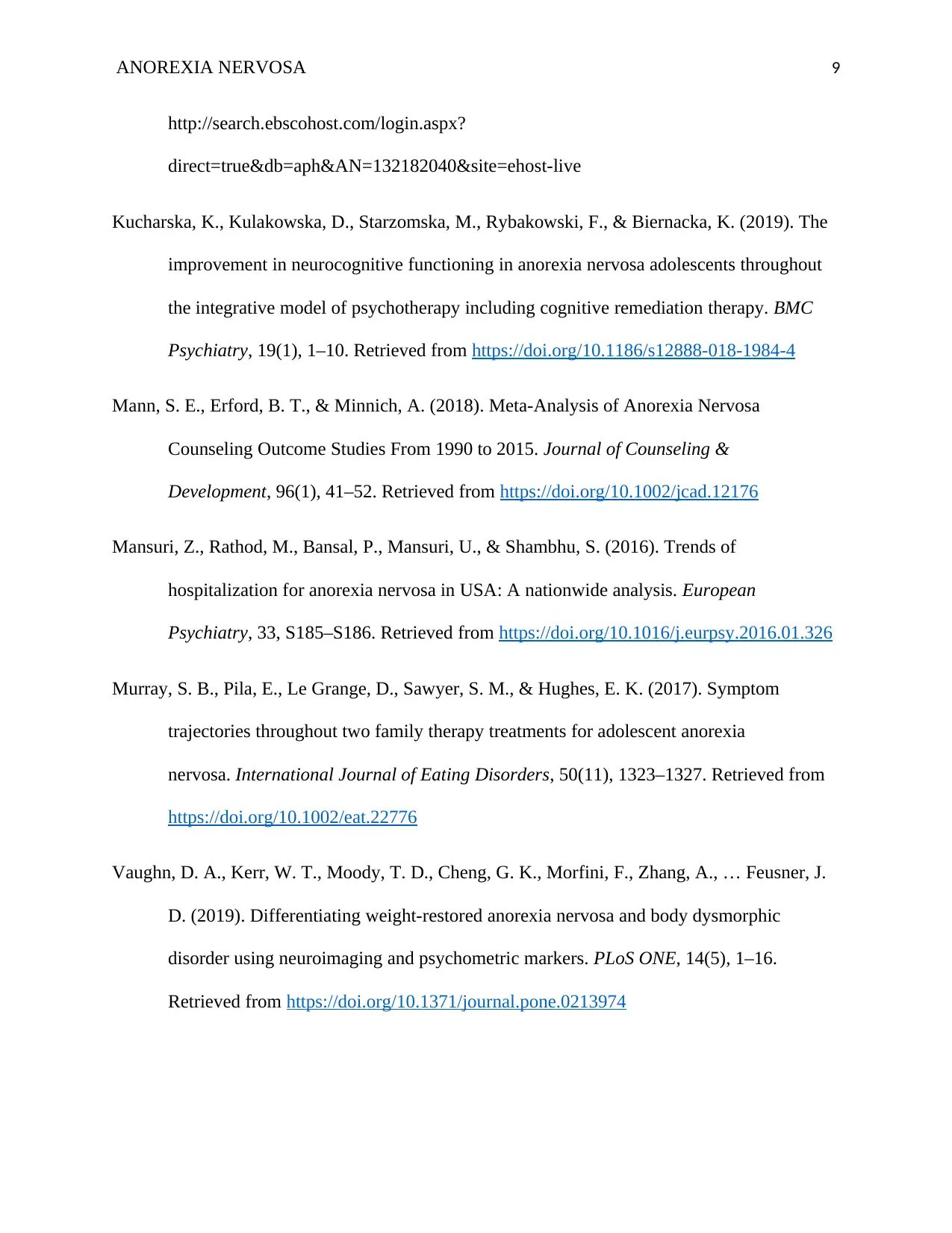
ANOREXIA NERVOSA 9
http://search.ebscohost.com/login.aspx?
direct=true&db=aph&AN=132182040&site=ehost-live
Kucharska, K., Kulakowska, D., Starzomska, M., Rybakowski, F., & Biernacka, K. (2019). The
improvement in neurocognitive functioning in anorexia nervosa adolescents throughout
the integrative model of psychotherapy including cognitive remediation therapy. BMC
Psychiatry, 19(1), 1–10. Retrieved from https://doi.org/10.1186/s12888-018-1984-4
Mann, S. E., Erford, B. T., & Minnich, A. (2018). Meta-Analysis of Anorexia Nervosa
Counseling Outcome Studies From 1990 to 2015. Journal of Counseling &
Development, 96(1), 41–52. Retrieved from https://doi.org/10.1002/jcad.12176
Mansuri, Z., Rathod, M., Bansal, P., Mansuri, U., & Shambhu, S. (2016). Trends of
hospitalization for anorexia nervosa in USA: A nationwide analysis. European
Psychiatry, 33, S185–S186. Retrieved from https://doi.org/10.1016/j.eurpsy.2016.01.326
Murray, S. B., Pila, E., Le Grange, D., Sawyer, S. M., & Hughes, E. K. (2017). Symptom
trajectories throughout two family therapy treatments for adolescent anorexia
nervosa. International Journal of Eating Disorders, 50(11), 1323–1327. Retrieved from
https://doi.org/10.1002/eat.22776
Vaughn, D. A., Kerr, W. T., Moody, T. D., Cheng, G. K., Morfini, F., Zhang, A., … Feusner, J.
D. (2019). Differentiating weight-restored anorexia nervosa and body dysmorphic
disorder using neuroimaging and psychometric markers. PLoS ONE, 14(5), 1–16.
Retrieved from https://doi.org/10.1371/journal.pone.0213974
http://search.ebscohost.com/login.aspx?
direct=true&db=aph&AN=132182040&site=ehost-live
Kucharska, K., Kulakowska, D., Starzomska, M., Rybakowski, F., & Biernacka, K. (2019). The
improvement in neurocognitive functioning in anorexia nervosa adolescents throughout
the integrative model of psychotherapy including cognitive remediation therapy. BMC
Psychiatry, 19(1), 1–10. Retrieved from https://doi.org/10.1186/s12888-018-1984-4
Mann, S. E., Erford, B. T., & Minnich, A. (2018). Meta-Analysis of Anorexia Nervosa
Counseling Outcome Studies From 1990 to 2015. Journal of Counseling &
Development, 96(1), 41–52. Retrieved from https://doi.org/10.1002/jcad.12176
Mansuri, Z., Rathod, M., Bansal, P., Mansuri, U., & Shambhu, S. (2016). Trends of
hospitalization for anorexia nervosa in USA: A nationwide analysis. European
Psychiatry, 33, S185–S186. Retrieved from https://doi.org/10.1016/j.eurpsy.2016.01.326
Murray, S. B., Pila, E., Le Grange, D., Sawyer, S. M., & Hughes, E. K. (2017). Symptom
trajectories throughout two family therapy treatments for adolescent anorexia
nervosa. International Journal of Eating Disorders, 50(11), 1323–1327. Retrieved from
https://doi.org/10.1002/eat.22776
Vaughn, D. A., Kerr, W. T., Moody, T. D., Cheng, G. K., Morfini, F., Zhang, A., … Feusner, J.
D. (2019). Differentiating weight-restored anorexia nervosa and body dysmorphic
disorder using neuroimaging and psychometric markers. PLoS ONE, 14(5), 1–16.
Retrieved from https://doi.org/10.1371/journal.pone.0213974
⊘ This is a preview!⊘
Do you want full access?
Subscribe today to unlock all pages.

Trusted by 1+ million students worldwide
1 out of 9
Related Documents
Your All-in-One AI-Powered Toolkit for Academic Success.
+13062052269
info@desklib.com
Available 24*7 on WhatsApp / Email
![[object Object]](/_next/static/media/star-bottom.7253800d.svg)
Unlock your academic potential
Copyright © 2020–2025 A2Z Services. All Rights Reserved. Developed and managed by ZUCOL.





